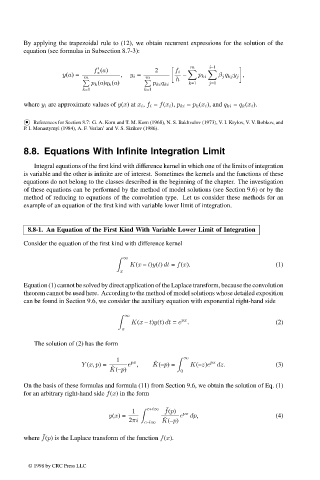Page 475 - Handbook Of Integral Equations
P. 475
By applying the trapezoidal rule to (12), we obtain recurrent expressions for the solution of the
equation (see formulas in Subsection 8.7-3):
m i–1
f (a) 2 f i
x
y(a)= , y i = – p ki β j q kj y j ,
h
m
m
p k (a)q k (a) p ki q ki k=1 j=1
k=1 k=1
where y i are approximate values of y(x)at x i , f i = f(x i ), p ki = p k (x i ), and q ki = q k (x i ).
•
References for Section 8.7: G. A. Korn and T. M. Korn (1968), N. S. Bakhvalov (1973), V. I. Krylov, V. V. Bobkov, and
P. I. Monastyrnyi (1984), A. F. Verlan’ and V. S. Sizikov (1986).
8.8. Equations With Infinite Integration Limit
Integral equations of the first kind with difference kernel in which one of the limits of integration
is variable and the other is infinite are of interest. Sometimes the kernels and the functions of these
equations do not belong to the classes described in the beginning of the chapter. The investigation
of these equations can be performed by the method of model solutions (see Section 9.6) or by the
method of reducing to equations of the convolution type. Let us consider these methods for an
example of an equation of the first kind with variable lower limit of integration.
8.8-1. An Equation of the First Kind With Variable Lower Limit of Integration
Consider the equation of the first kind with difference kernel
∞
K(x – t)y(t) dt = f(x). (1)
x
Equation (1) cannot be solved by direct application of the Laplace transform, because the convolution
theorem cannot be used here. According to the method of model solutions whose detailed exposition
can be found in Section 9.6, we consider the auxiliary equation with exponential right-hand side
∞
px
K(x – t)y(t) dt = e . (2)
x
The solution of (2) has the form
1 px ∞ pz
˜
Y (x, p)= e , K(–p)= K(–z)e dz. (3)
˜
K(–p) 0
On the basis of these formulas and formula (11) from Section 9.6, we obtain the solution of Eq. (1)
for an arbitrary right-hand side f(x) in the form
˜
1 c+i∞ f(p) px
y(x)= e dp, (4)
˜
2πi c–i∞ K(–p)
˜
where f(p) is the Laplace transform of the function f(x).
© 1998 by CRC Press LLC
© 1998 by CRC Press LLC
Page 457

